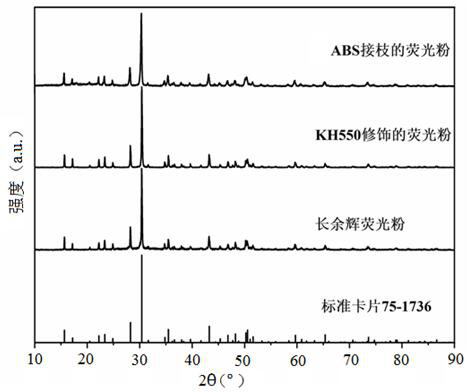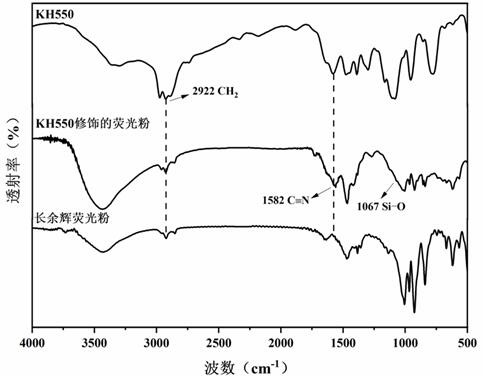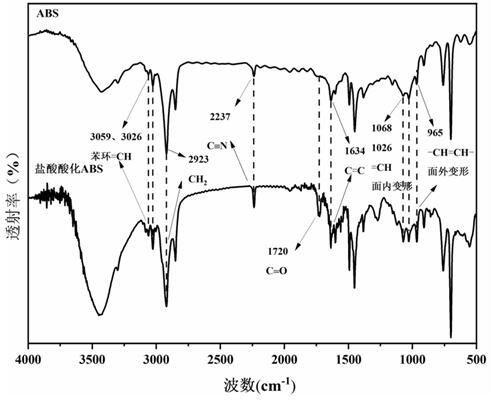3D printing ABS composite material capable of continuously emitting light and preparation method thereof
A 3D printing and composite material technology, applied in the field of 3D printing ABS composite materials and its preparation, can solve the problems of poor mechanical properties, no luminescence characteristics, and limited applications
- Summary
- Abstract
- Description
- Claims
- Application Information
AI Technical Summary
Problems solved by technology
Method used
Image
Examples
Embodiment 1
[0036] The long afterglow phosphor (Sr 2 MgSi 2 o 7 : Eu 2+ , Dy 3+ ); according to the mass percentage, take 1% long afterglow phosphor, 1% KH550, 90% of ABS particles and 8% of ABS powder respectively; divide the obtained ABS powder into two parts, the mass of the first part of ABS powder is the obtained 1% of the mass of the ABS powder, and the mass of the second part of the ABS powder is 99% of the mass of the obtained ABS powder; according to the ratio of adding 1 mL of KH550 to 50 mL of deionized water, add KH550 to the deionized water, stir for 5 minutes, and after the hydrolysis reaction, Add long afterglow phosphor, reflux at 80°C for 10h (speed 250r / min), cool naturally to room temperature, centrifuge, filter and wash with deionized water several times to remove unreacted KH550, dry in a vacuum oven at 80°C until constant Reconstitute and grind to obtain KH550-modified phosphor; add the first part of ABS powder to hydrochloric acid according to the ratio of addin...
Embodiment 2
[0041] The long afterglow phosphor (Sr 2 MgSi 2 o 7 : Eu 2+ , Dy 3+ ); according to mass percentage, respectively take 2% of long-lasting phosphor, 2% of KH550, 89% of ABS particles and 7% of ABS powder, divide the obtained ABS powder into two parts, the mass of the first part of ABS powder is The mass of the obtained ABS powder is 3%, and the mass of the second part of the ABS powder is 97% of the mass of the obtained ABS powder; according to the ratio of adding 3 mL of KH550 to 50 mL of deionized water, add KH550 to the deionized water, stir for 10 minutes, and the hydrolysis reaction Finally, add long afterglow phosphor, reflux at 70°C for 24h (speed 500r / min), cool naturally to room temperature, centrifuge, filter and wash with deionized water several times to remove unreacted KH550, and dry in a vacuum oven at 75°C Grind to constant weight to obtain phosphor powder modified by KH550; Add the first part of ABS powder to hydrochloric acid according to the ratio of 5g AB...
Embodiment 3
[0046] The long afterglow phosphor (Sr 2 MgSi 2 o 7 : Eu 2+ , Dy 3+ ); according to the mass percentage, respectively take 3% of long-lasting phosphor, 3% of KH550, 88% of ABS particles and 6% of ABS powder; divide the obtained ABS powder into two parts, the mass of the first part of ABS powder is 2% of the mass of the obtained ABS powder, and the mass of the second part of the ABS powder is 98% of the mass of the obtained ABS powder; according to the ratio of adding 2 mL of KH550 to 50 mL of deionized water, add KH550 to the deionized water, stir for 8 minutes, and hydrolyze Finally, add fluorescent powder, reflux at 75°C for 17h (speed 200r / min), cool naturally to room temperature, centrifuge, filter and wash with deionized water several times to remove unreacted KH550, and dry in a vacuum oven at 70°C until constant Re-grind to get KH550-modified phosphor; add the first part of ABS powder to hydrochloric acid according to the ratio of 3g ABS powder to 50mL hydrochloric ...
PUM
 Login to View More
Login to View More Abstract
Description
Claims
Application Information
 Login to View More
Login to View More - R&D
- Intellectual Property
- Life Sciences
- Materials
- Tech Scout
- Unparalleled Data Quality
- Higher Quality Content
- 60% Fewer Hallucinations
Browse by: Latest US Patents, China's latest patents, Technical Efficacy Thesaurus, Application Domain, Technology Topic, Popular Technical Reports.
© 2025 PatSnap. All rights reserved.Legal|Privacy policy|Modern Slavery Act Transparency Statement|Sitemap|About US| Contact US: help@patsnap.com



